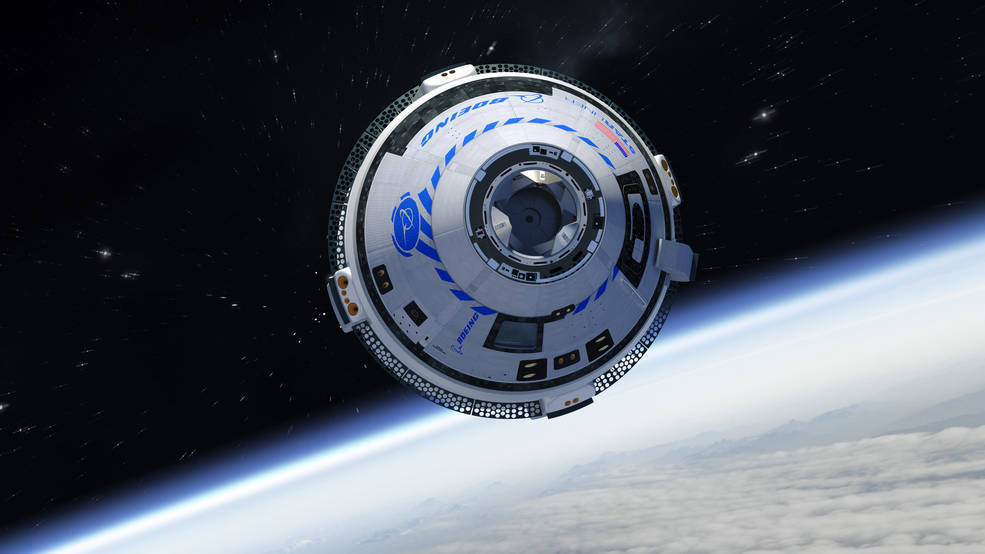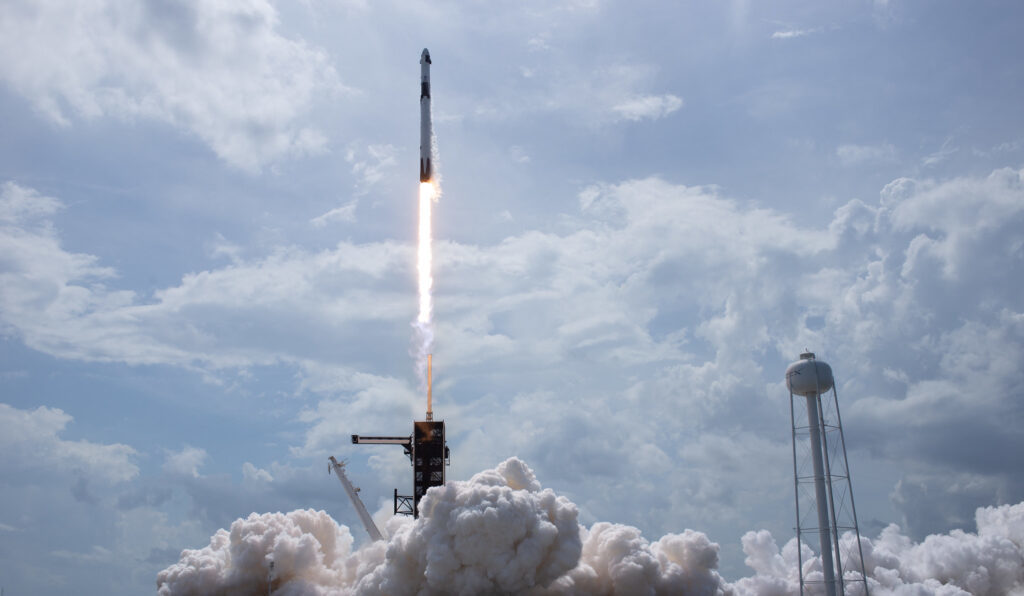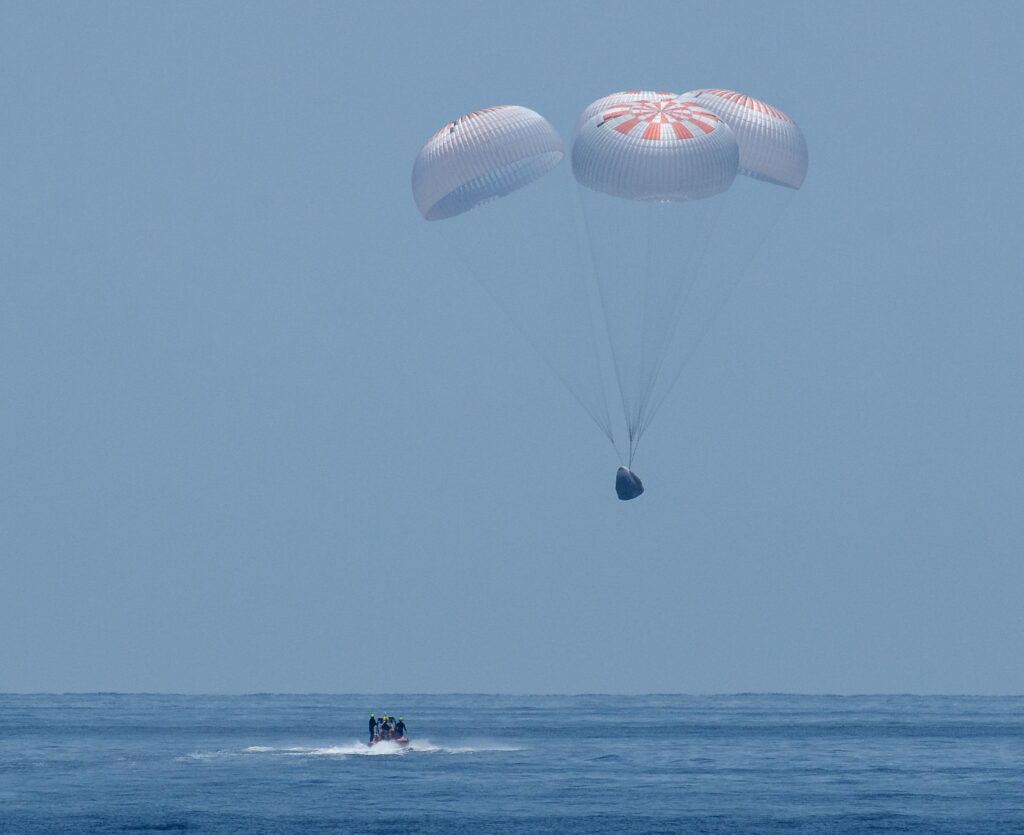SpaceX beats Boeing in the race launching NASA astronauts from American soil.
When it all began?
It all began in 2010, When NASA announced Commercial Crew Program. The main goal was to get private players to develop and operate a new generation of spacecraft and launch systems capable of carrying crews to low-Earth orbit and the International Space Station.

Initially Boeing was selected for the Commercial Crew development program to develop a proposed design in 2010 for 18 million dollars and then continued its development 2011 for another 93 million.
By this time SpaceX owner Elon Musk that convinced NASA it could be a serious contender for manned spaceflight so the agency awarded SpaceX 75 million in the same year to begin development based on its dragon freighter.
In 2012 Boeing and SpaceX were awarded an additional 460 million and 440 million respectively to continued development with both hitting sufficient milestones the two companies received a final award in 2014 of 4.2 billion and 2.4 billion respectively for development in production that resulted in the first man launch of a commercial crew capsule to the ISS.
It would take SpaceX six more years to certify its man Dragon capsule for spaceflight with NASA this was 5 years before the originally scheduled manned flight of Orion in the canceled constellation program and at least one year before Boeing could hope to certify its commercial Starliner capsule.

How SpaceX beat Boeing?
The Commercial Crew Program was structured as a multi-tier competition, with companies bidding for NASA contracts to build the space transportation systems under specific parameters set forth by the agency. NASA eventually awarded the contracts to Boeing and SpaceX.

For the last 10 years both the companies where side by side, building and testing their crew transportation systems. But SpaceX’s successful launch in May marked a major milestone for the company, leaving Boeing to catch up. It was the 1st time that NASA astronauts took off from U.S. soil since 2011 and the first time a commercially built spacecraft carried NASA astronauts.
So, why did Boeing in spite of its historical political and funding advantage fall behind SpaceX in the commercial manned space race?
In short it came down to 2 main things,
- Management Issue
- Cost Structure
Firstly let’s look at Management Issues,
SpaceX the developer of the Dragon 2 spacecraft SpaceX its CEO is Elon Musk who is also CEO of Tesla an electric vehicle solar power and power storage systems company in a set of small startups like the boring company.
Elon is an engineer a fact which cannot be overstated musk is an engineer first and an entrepreneur second.
His career has been defined by the interest in solving problems the companies that he runs and have run were and are just conveyances to solve those problems the SpaceX has the minimum number of employees necessary to execute Elon’s objectives.
The pomp and ceremony of being the CEO of a large and prestigious corporation is really secondary as is the prospect of earning large sums of money as the majority owner and CEO Elon doesn’t draw a salary to pay himself bonuses of course Elon needs a CFO and accountants to report figures to the board and investors.
Also, because SpaceX deals in technology that the US government considers extremely expensive there’s an executive who worries about that requirement.
Gwynne Shotwell is the president COO and practice this means she is responsible for landing and maintaining business from the US government foreign governments and commercial companies Shotwell gets a lot of credit for making SpaceX successful and deservedly so as managing NASA the FAA the US Air Force and Congress
It is an incredibly tough job never mind soliciting other business making sure SpaceX runs smoothly SpaceX has scientists and engineers who run designed engine and Materials Research the top scientists and engineers are the executives there is also an executive engineer that runs SpaceX is production and launches.
And that’s it although SpaceX has 1000 of employees has a fairly flat organizational structure is geared to solving problems and achieving results.
Boeing the developer of the Starliner spacecraft is an incredibly large company it has 143 thousand employees which is about 20 times as many as SpaceX.
Boeing of course manufactures commercial aircraft to its namesake division as well as through brazil’s Embraer and has some other businesses related to the aircraft industry these areas are also not relevant to the Starliner.
The head of Boeing’s defense and space business which is code for everything related to the US government it’s Leanne Caret, she has been in charge since 2016 when her predecessor Chris Chadwick.
Leanne is an MBA who spent her career in program management, Being program managers are the superstars of a government contracting world they’re essentially fixers in an above board sense for their managers don’t design or engineer anything they manage people both internally and externally the program schedule and program cost.
Leanne the closest analogue is Gwynne Shotwell who is COO of SpaceX but that’s a little deceiving as Shotwell is a salesperson supported by an excellent cast of engineers and correct as a program manager matrix with a cadre of retired government officials of both new businesses.
Caret is responsible for all of Boeing’s defense and space operations which are extensive and not even remotely related to Starliner this is why she has John Mulholland Vice President running the Starliner program for her.
Mulholland is a career program manager in turn Mulholland has a series of program managers reporting to him that each run a portion of Starliner development production and launch operations these program managers are matrix to a pool of engineers scientists fabricators procurement officers administrative personnel and various specialists.
Each program manager has a schedule a budget science staff if you’re starting to get a sense of the management complexity of Boeing that is the point the primary objective of Boeing.
Boeing Starliner is to deliver revenue at reduced risk this management structures therefore designed to the maximize revenue and spread risk and contrast space axis structure has evolved to maximize space travel with acceptable risk.
Now let’s look at the Cost Structure,
It is likely SpaceX structures its accounting somewhat different than most space and defense companies particularly given that the company has been living off of fixed price contracts from NASA
An open market commercial pricing but for the sake of comparison we have categorized expenses in such a way to allow us to understand the difference between SpaceX and Boeing and how those differences may give SpaceX an advantage.
A contract can be broken down into direct cost of providing goods and services such as labor materials and indirect costs such as selling and rent for direct costs.
We are highlighting labor and fringe benefits materials contractors and other direct costs such as travel for indirect costs we’re highlighting overhead such as rent and labor supervision selling an administrative expense management and incentives.
And of course, every contract has profit which the US government thinks of as the fee SpaceX was awarded a 2.4 billion fixed price contract to design build and certify a spacecraft for manned flight.
note that all the cost we are showing our estimates meant to merely demonstrate the scope of cost differences between SpaceX and Boeing.
SpaceX is a private company that does not release its financials and Boeing does not break our Starliner and its public financial results direct labor and fringe benefits such as health care employee taxes and retirement expense is typically, a third of the contract cost in a contract that has significant labor and material components and deliverable articles that are a low-rate production one third
In this case is about 840 million dollars direct materials for final engineering and building of the manned spacecraft as well as the acquisition or building of the rocket needed to launch the spacecraft to the ISS will likely be another third of the contract multiple test articles will be needed as well as the expenditure of a significant amount of fuel the figure we are estimating is about 720 million.
SpaceX mostly operates in-house but every company needs a source specialists and SpaceX is no different other direct costs such as meals travel and incidentals are normal for such contract we are estimating about 5% of the contract cost for these items 420 million dollars each SpaceX incurs rent at its Hawthorne, California plant as well as at the Kennedy Space Center in Florida.
What the company will launch the dragon space craft and at scattered other facilities around the country Foreman and supervisors not specifically tied to a deliverable item in the CCD program will also be needed to manage personnel and facilities these overhead items as well as a number of others
We estimated tempts of the contract or 240 million dollars selling activities such as interfacing with a customer and managing relationships with other interests to government agencies or every umber small cost.
As such a contract and of course accounting and general administration are needed to make sure budgets are met and contract reporting requirements are satisfied this area also includes indirect items like insurance legal costs regulatory compliance.
We estimate this is another 8% of the contract cost or 192 million dollars management cost is for the compensation of Shotwell and the other executives as well as the engineering directors and specialists directors that function as SpaceX management.
Elon does not draw compensation directly from the contract or indirectly as an allocation the rather participates in the company’s equity structure incentives refer to annual performance bonuses and specific targeted objectives that the management and other subject matter experts can earn in addition to their normal salaries.
We estimate management compensation incentives to be another 3% of the contract cost or 72 million dollars.
That leaves just one item in the contract cost structure the fee NASA typically allows for a fee in addition to allowable costs ranging between 3% and 5% we are using 4% here or 96 million dollars and that’s the total picture for the SpaceX CCD contract actual costs will likely vary particularly given the nature of the multi-year fixed price contract that contains considerable design performance risk as every space related venture does.
SpaceX may have under run its cost objectives for example although it was more likely they have overrun them given the delays in its own schedule for example the destruction of the demo1 test article static fire tests in April of 2019 results in at least a six-month delay of a SpaceX satisfied NASA and understood the problem and applied a workable solution.
Boeing on the other hand received 4.2 billion for essentially an identical contract the only significant difference being the need to buy an Atlas V launch vehicle from the United Launch Alliance instead of building its own rocket SpaceX is internal cost for Falcon 9 launch vehicle it’s 37 million dollars the ULA charges between 100 million to 150 million for an Atlas V.

We start by adding a new cost category to our list allocation Boeing Starliner program has to pay for a portion of the company’s corporate costs which include the facilities and personnel related to the executives on the CEO staff as well as the CEO himself.
SpaceX is a smaller and flatter company doesn’t have this cost as with SpaceX we estimate labor and fringe benefits to be low less than a third of the contract since the contract is larger the amount of this category is larger.
This doesn’t mean that Boeing personnel are any less capable than SpaceX personnel or that they are more expensive rather the higher cost is a representation of the way Boeing program management superstructure compartmentalizes resources and short the structure requires more resources.
Again, as with SpaceX we estimate materials to be low less than a 3rd of the contract the actual figure ends up being 60% higher than that for SpaceX reflecting Boeing’s reliance on mi spec and aerospace grade hardware historically found to be the least risk and most reliable for space missions.
SpaceX relies on triple redundant standard commercial spec hardware this is bitten SpaceX at least once the CRS 7 mission exploded during launch due to a failure of an industrial-grade fastener used to secure a support strut the second stage liquid oxygen tank.
But it should be noted that NASA has certified SpaceX’s approach on specifications contractor other direct costs and overhead rest mated to be similar to that of SpaceX on a percentage basis which yields a proportionately higher number for each category sawing expense administration is estimated to be 10% of the contract instead of 8%
That is because of SpaceX reflecting a more robust internal control reporting structure fired for public company regulatory compliance as well as higher costs for the retention of retired government officials and general selling expense because of the program management structure.
At Boeing management costs and incentives are estimated to be three times the cost than at SpaceX furthermore corporate allocation is estimated to be an additional one third of the management and incentives costs fee is expected to be the same at Boeing as at SpaceX about 4%.
The true fee is actually negative for Boeing’s contract as the company is expected to have to swallow the estimated 410 million dollars cost the second unmanned test flight later in 2020.
However Boeing like SpaceX will own the rights to its commercial manned spacecraft instead of NASA and this should provide long-term compensation for the loss management structure and cost differences both suggest operational inefficiencies and increased complexity over that at SpaceX some of this is inherent in the difference between a privately held and publicly held company some of the differences.
Result from the sheer size of Boeing versus that of SpaceX and some of the difference no doubt arises from the historical Boeing operates under.
While SpaceX features the lean operating structure of a company that built itself without the burden of any preconceived notions.

Finally SpaceX became the first private company to launch NASA astronauts to space from American soil since shuttle mission retired back in 2011.

On August 3rd both the astronauts returned to Earth after 63 days of test flight to the International Space Station.
Additional Resources:
